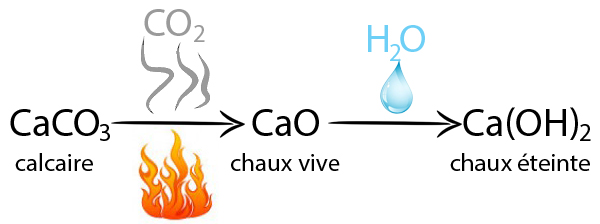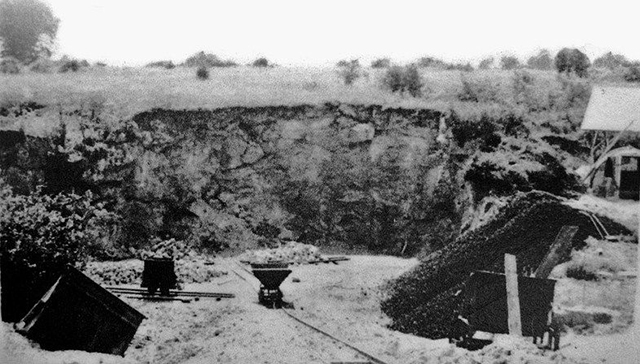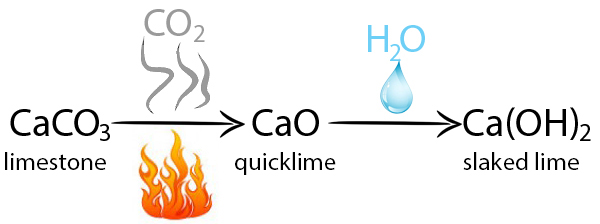
Le four à chaux ou chaufour est une catégorie de four à calcination dans lequel on transforme le calcaire en chaux par calcination et accessoirement où l’on cuit la céramique. C'est généralement un ouvrage vertical fixe et ouvert par le haut, mais on trouve également des fours horizontaux et rotatifs.
La fabrication de la chaux constitue l'art du chaufournier.
Principe
La chaux est obtenue par calcination d'une pierre calcaire à environ 800 à 1000 °C, dans des fours à chaux, opération pendant laquelle du dioxyde de carbone (CO2) et de l'oxyde de calcium (CaO, aussi appelé " chaux vive ") sont produits. Cette dernière prend l'apparence de pierres pulvérulentes en surface.
L'opération suivante consiste à hydrater (" éteindre ") ces pierres par immersion dans l'eau. Cette réaction très exothermique transforme le CaO en hydroxyde de calcium (Ca(OH)2) et provoque la dislocation ainsi qu'un foisonnement. Le résultat est une pâte, qui prend le nom de " chaux éteinte ". La présence d'autres composés (argiles…) dans la pierre peut modifier la phase d'extinction, conduisant à produire différents types de chaux.

Le chaufour de Baives
Construit au XIXème siècle, le four à chaux de cette commune est un imposant monument de pierres bleues. Il est l’un des derniers du Nord. Il est le vestige d’une activité industrielle locale liée à l’exploitation d’une carrière de calcaire :

Situé juste derrière cette carrière pour faciliter l’acheminement de la roche, ce four à chaux fonctionna jusque dans les années 50 :

Ce bâtiment est aujourd’hui habité par 6 espèces différentes de chauves-souris, dont le « Grand Murin », le plus grand mammifère volant de cette famille d’animaux en Avesnois. Son envergure peut atteindre 45 centimètres.
La chaux est réalisée grâce à la pierre calcaire réduite en petits morceaux. Le four était alimenté par son ouverture située en haut (appelée le «gueulard»). Les chaufourniers alternaient les lits de pierre et de charbon pour le remplir au maximum. Il devait alors maintenir une température entre 800 et 1000 degrés C pour obtenir une cuisson parfaite de la pierre. Dès que cette opération était réalisée, la chaux était récupérée grâce à une ouverture basse du four appelée « l'ébraisoir ». La chaux vive était alors éteinte dans une fosse adjacente à l'aide d'une grande quantité d'eau. La chaux éteinte était par la suite placée dans des barils avant d'être utilisée en maçonnerie ou pour la réalisation d'enduits. La chaux vive était également utilisée comme désinfectant corrosif.

La earthcache

Pour pouvoir valider cette earthcache, vous devrez répondre aux questions suivantes.
Merci d’envoyer vos réponses via mon profil ou via la messagerie geocaching.com, ne les donnez pas dans votre log.
Vous pouvez ensuite loguer la cache "found it", je vous contacterai en cas de problème.
1) A quelle température faut-il chauffer le calcaire pour obtenir de la chaux vive ?
2) Quels sont le nom scientifique et la formule chimique de la chaux vive ?
3) Quels sont le nom scientifique et la formule chimique de la chaux éteinte ? Comment l’obtient-on ?
4) Quel est le diamètre du « gueulard » de ce chaufour (encore visible au sommet) ?
5) Qu’est-ce qui a incité les chauves-souris à s’installer dans ce four (panneau d’information) ?
6) Vous pouvez également ajouter à votre log une photo de vous ou de votre GPS devant le four (facultatif, mais grandement apprécié).

The lime kiln or chaufour is a calciner category in which converts limestone into lime calcining and incidentally where we cooked ceramics. This is usually a fixed vertical work and open at the top, but there are also horizontal and rotary kilns.
The lime production is the art of lime burner.
Principle
Lime is obtained by calcining limestone at about 800 to 1000 ° C in lime kilns, operation during which carbon dioxide (CO2) and calcium oxide (CaO, also called "quicklime") are produced. The latter takes the appearance of powdery stone surface.
The next step is to hydrate ("off") these stones by immersion in water. This very exothermic reaction transforms the CaO to calcium hydroxide (Ca(OH)2) and causes dislocation and a profusion. The result is a paste, which takes the name of "slaked lime". The presence of other compounds (clay...) in the stone can change the extinction phase, leading to produce different types of lime.

The chaufour of Baives
Built in the nineteenth century, the lime kiln of this town is an imposing monument of blue stones. It is one of North latter. It is the remnant of a local industrial activity related to the operation of a limestone quarry :

Right behind this career to facilitate the delivery of the rock, lime kiln worked into the 50s:

This building is now inhabited by 6 different species of bats, including the "Grand Murin", the most great flying mammal of this animal family in Avesnois. Its wingspan can reach 45 centimeters.
Lime is produced thanks to the limestone reduced to small pieces. The oven was fueled by the opening at the top (called the "gueulard"). The limeburners alternated stone and coal beds to fill the maximum. He then had to maintain a temperature between 800 and 1000 degrees C for perfect baking stone. As soon as this operation was performed, the lime was recovered by a low oven opening called the "ébraisoir". The quicklime was slaked then in an adjacent pit using a large amount of water. Slaked lime was subsequently placed in barrels before being used in masonry or for producing coatings. Quicklime was also used as corrosive disinfectant.

The earthcache

To be allowed to validate this earthcache, you will have to answer the following questions.
Thank you for sending your answers via my profile or the geocaching.com messaging, don't take it in your log.
You may then post your log "found it", I shall contact you in case of problem.
1) At what temperature should you heat the limestone for quicklime?
2) What are the scientific name and the chemical formula of quicklime?
3) What are the scientific name and the chemical formula of slaked lime? How is it obtained?
4) What is the diameter of the "gueulard" of this lime kiln (still visible at the top)?
5) What has prompted bats to settle in this oven (information board)?
6) You may alsoadd to your log a photo of you or your GPS in front of the lime kiln (optional but greatly appreciated).